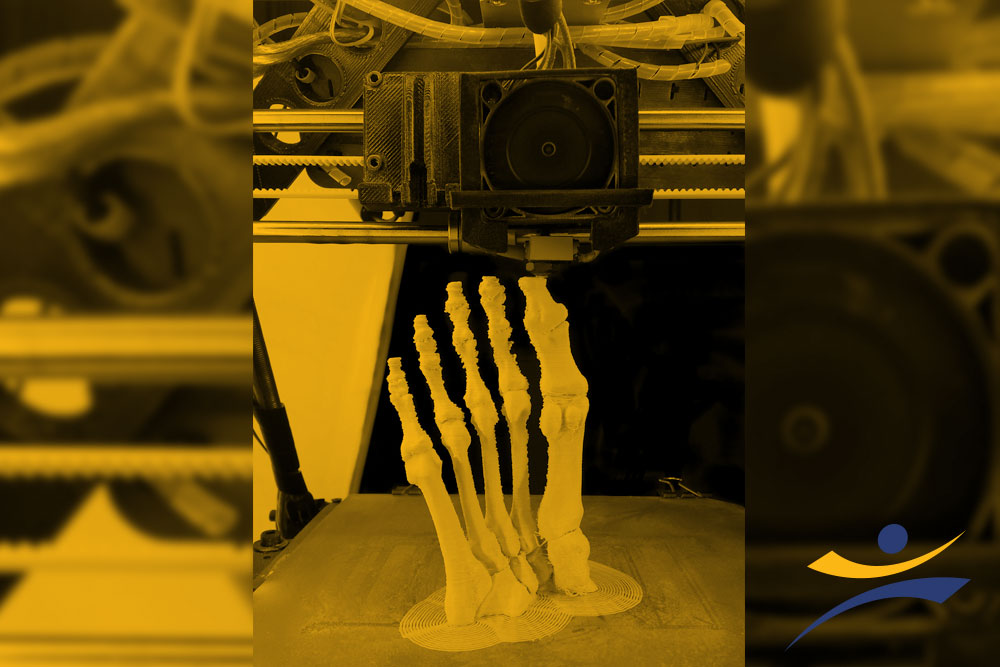
As orthopedists, we like to keep watch for advances in 3D printing, and just how important it is becoming to the medical field. While 3D printing technology has been around for more than 30 years, it has recently been a hot topic in the news, especially with the announcement that Carolina Panthers linebacker Thomas Davis, Sr. would be wearing a customized 3D printed brace in the Superbowl. This highly personalized brace allowed him to continue playing at an elite level despite injury. But at The Central Orthopedic Group, we recognize that braces are only the beginning of what 3D printing can do for medicine.
 Image from panthers.com
Image from panthers.com
3D printing, also known as additive manufacturing, has revolutionized the ability to create objects with unprecedented precision. Unlike traditional subtractive manufacturing, which removes material from a block, 3D printing builds objects layer by layer from digital files. This technology allows for complex geometries that were previously impossible to produce, making it particularly valuable in the medical field where customization is essential.
“3D Printed braces are just skimming the
surface of Orthopedic Possibilities!”
Orthopedic surgeons, including our team at the Central Orthopedic Group, are especially excited about the potential of 3D printing for patient-specific solutions. When a patient receives a CT scan, MRI, or X-ray, the resulting digital file can be converted into a three-dimensional blueprint. This creates an exact model of an individual patient’s anatomy, including any abnormalities or injuries. For surgeons, this offers a tremendous advantage: the ability to visualize and practice on a precise replica of the patient’s joint, bone, or structure before performing surgery. This level of preoperative planning significantly improves surgical outcomes.
For instance, consider a patient undergoing a complex spinal fusion procedure. Traditional planning relies heavily on imaging and the surgeon’s experience. With 3D printed models, the surgeon can simulate the operation, plan the optimal angle for screws and implants, and anticipate any challenges. This not only shortens the time spent in the operating room but also reduces the risk of errors, improving overall patient safety and recovery time.
Custom 3D Printing for Orthopedics
Beyond preoperative planning, 3D printing allows for the creation of customized surgical guides, implants, and prosthetics. For example, if a patient requires a knee replacement or spinal implant, a 3D printed model can be used to ensure that implants fit precisely, reducing the likelihood of post-operative complications. In trauma cases, surgeons can design patient-specific plates or screws that perfectly match the unique anatomy of a fractured bone.
3D printing has also been transformative in the field of prosthetics. Traditional prosthetic devices often require multiple fittings, can be expensive, and may not fully accommodate the individual’s anatomy. With 3D printing, prosthetic limbs can be produced quickly, at lower costs, and with a precise fit. This allows for greater comfort, improved mobility, and the opportunity to create prosthetics tailored to the patient’s lifestyle, from athletic use to everyday functionality.
In addition to prosthetics, 3D printing has enabled breakthroughs in facial reconstruction. Patients who suffer trauma or congenital deformities benefit from highly accurate models of their facial structures. Surgeons can use these models to plan intricate procedures, ensuring better cosmetic and functional outcomes. This has been particularly valuable in reconstructive surgeries following accidents or tumor removals.
Other 3D Printing Developments for Orthopedics
Another exciting development in orthopedics is the use of 3D printed scaffolds for tissue engineering. Scientists are experimenting with printing biocompatible structures that mimic bone and cartilage. These scaffolds can be seeded with a patient’s own stem cells, encouraging natural tissue regeneration. While still in research phases, this technique has the potential to revolutionize the treatment of severe bone injuries, degenerative joint disease, and cartilage defects.
Sports medicine has also seen significant benefits from 3D printing. Athletes often require braces, supports, or customized orthotics to prevent injury or aid recovery. Traditional braces are generic and may not provide optimal support. With 3D printing, orthopedic specialists can design and produce braces that perfectly conform to an athlete’s anatomy. This allows for maximum protection while maintaining comfort and mobility, whether for ACL recovery, wrist support, or shoulder stabilization.
Custom 3D printed braces have already made headlines in professional sports. Thomas Davis Sr.’s 3D printed brace allowed him to perform at the highest level despite a knee injury, highlighting the potential of this technology to extend athletic careers and improve quality of life for injured individuals. At the Central Orthopedic Group, we see similar applications for patients of all activity levels, from weekend warriors to elite athletes.
3D printing also has the potential to transform surgical education and training. Medical students and residents can practice complex procedures on realistic, patient-specific models before entering the operating room. This hands-on experience improves surgical proficiency and reduces learning curves, ultimately enhancing patient outcomes.
What Materials are used in 3D Printing for Orthopedics?
Materials used in 3D printing continue to evolve. Modern printers can create objects from plastics, silicone, titanium, gold, silver, ceramics, wax, and even food. Some prototypes are capable of printing with multiple materials simultaneously, allowing for structures that mimic the density and properties of human tissue. For orthopedic implants, this means stronger, more natural-feeling components that integrate better with the body’s anatomy.
3D printing is also contributing to cost savings in medicine. While traditional custom implants and prosthetics can take months to design and manufacture, 3D printing can produce accurate models and devices in a fraction of the time. This efficiency allows hospitals and surgical centers to treat more patients with faster turnaround, without compromising on quality.
Patients also benefit from the educational aspect of 3D printed models. By holding a replica of their own anatomy, patients can better understand their injury, the planned procedure, and expected outcomes. This visual and tactile experience helps reduce anxiety, improve compliance with treatment plans, and foster trust between patient and surgeon.
The global adoption of 3D printing in medicine is accelerating. In Japan, for example, the Ministry of Health, Labour, and Welfare now covers the cost of 3D printed organ models used in surgeries, ensuring access to life-saving procedures. Hospitals around the world are investing in 3D printing labs to support complex surgical planning, prosthetics, and patient-specific devices.
The Future of 3D Printing in Orthopedics
Looking to the future, the integration of 3D printing with technologies such as artificial intelligence and robotics may further transform orthopedics. AI algorithms could optimize implant design based on patient-specific data, while robotic surgery could utilize 3D printed guides for ultra-precise procedures. These innovations promise shorter recovery times, fewer complications, and improved long-term outcomes for patients of all ages.
At the Central Orthopedic Group, we are committed to staying at the forefront of these technological advancements. Our goal is to combine state-of-the-art tools like 3D printing with the expertise of our orthopedic surgeons to provide personalized, effective, and innovative care. Whether you need a custom brace, a surgical implant, or assistance with rehabilitation, 3D printing opens new avenues to meet your unique needs.
Today’s 3D Printers have the ability to create objects in a multitude of materials, including:
- Plastics
- Silicone
- Silver
- Gold
- Titanium
- Other Metals
- Ceramics
- Wax
- Food
Future printers may combine multiple materials simultaneously. Researchers at the Massachusetts Institute of Technology have created a prototype capable of printing models with up to 10 different materials at once. This multi-material capability opens new possibilities for creating prosthetic devices and medical models that mimic the natural variation in human tissue.
Did You Know?
A sector of the Japanese Ministry of Health, Labour and Welfare has announced that the cost of 3D printed organ models for medical treatment and surgeries will now be covered by standard medical insurance. This initiative ensures that patients have access to life-saving procedures and highlights the growing global acceptance of 3D printing in modern medicine.
How 3D Printing Benefits Patients:
- Shorter Surgery Times: Surgeons can practice and plan procedures on exact replicas.
- Reduced Risk: Customized implants and guides improve surgical precision.
- Personalized Care: Devices and braces fit the individual, improving comfort and effectiveness.
- Improved Recovery: Accurate implants reduce complications and speed rehabilitation.
- Innovative Solutions: Complex or rare anatomical issues can be addressed with customized 3D solutions.
In conclusion, 3D printing is transforming the orthopedic field. From braces and surgical models to prosthetics and custom implants, this technology allows for personalized solutions that improve surgical outcomes, patient comfort, and long-term functionality. At The Central Orthopedic Group, we remain committed to exploring and implementing these innovative solutions to provide the highest level of care for our patients, today and in the future.
